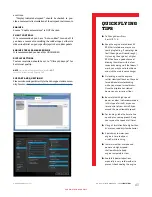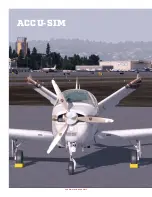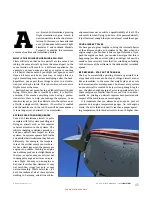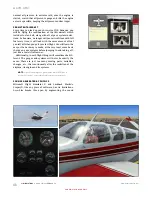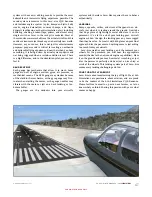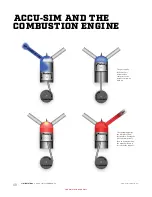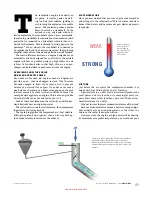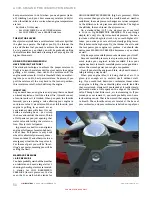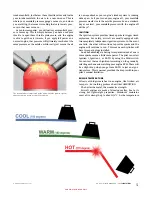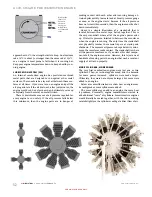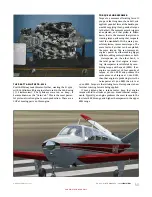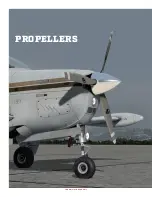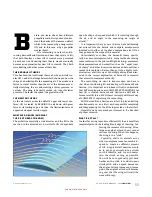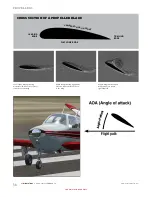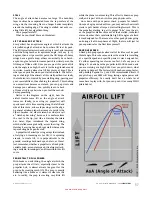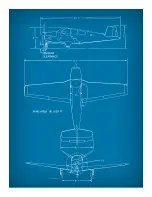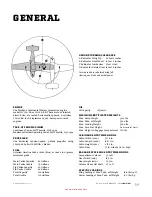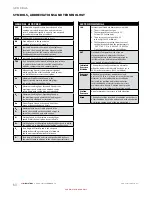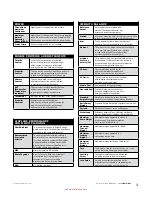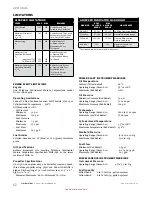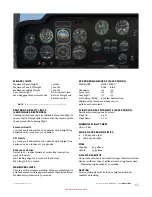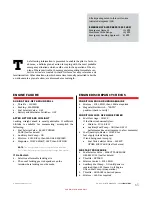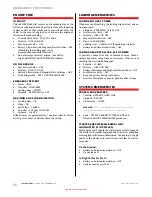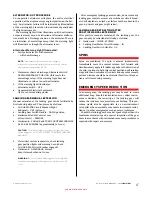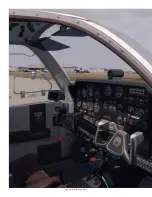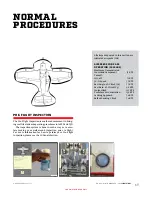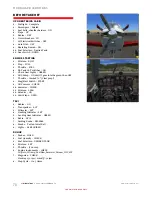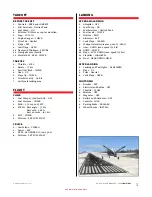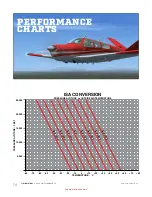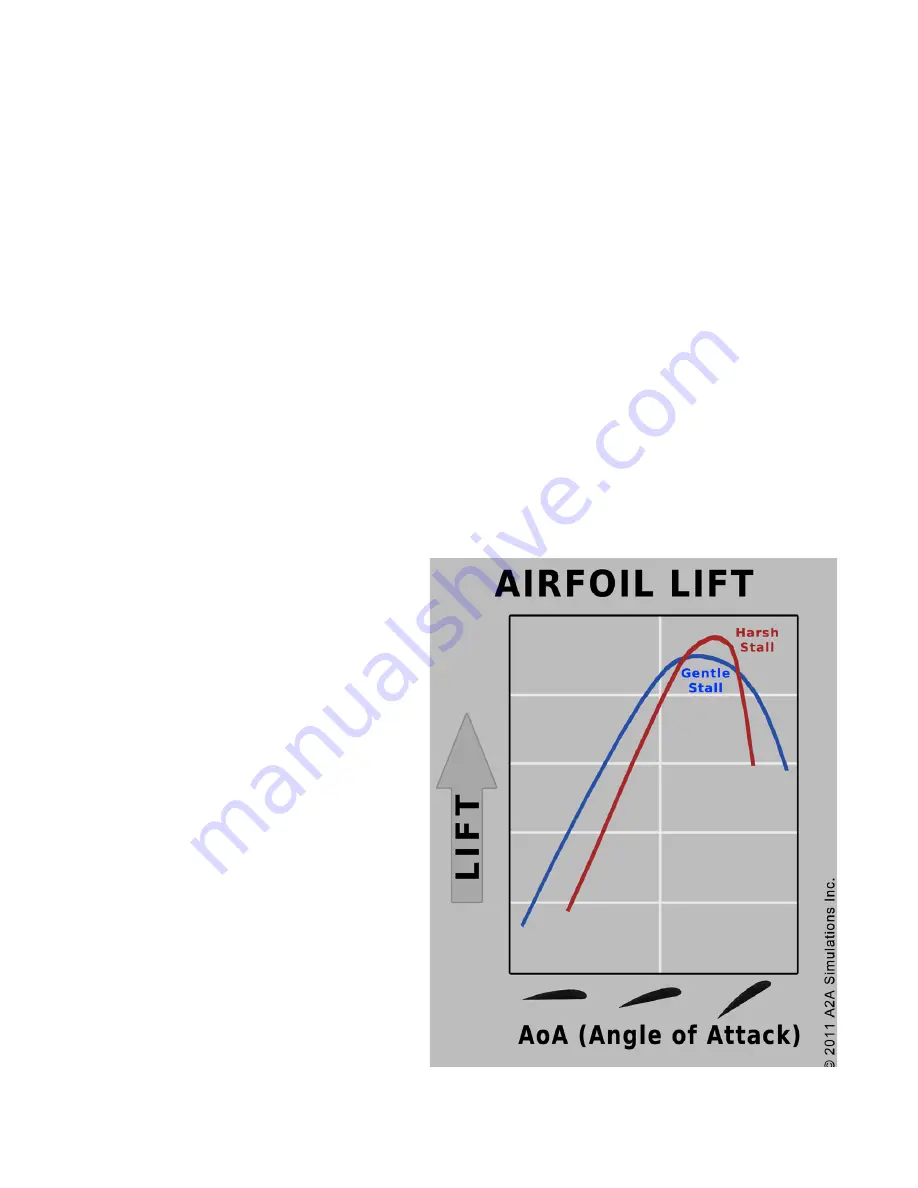
www.a2asimulations.com
ACCU-SIM V35B BONANZA
:::
A2A
SIMULATIONS
57
FOR SIMULATION USE ONLY
STALL
The angle of attack has become too large. The boundary
layer vortices have separated from the top surface of the
wing and the incoming flow no longer bends completely
around the leading edge. The wing is stalled, not only cre-
ating little lift, but significant drag.
Can a propeller stall?
What do you think? More on this below.
LIFT VS ANGLE OF ATTACK
Every airfoil has an optimum angle at which it attacks the
air (called angle of attack, or AoA), where lift is at its peak.
The lift typically starts when the wing is level, and increases
until the wing reaches its optimum angle, let’s say 15-25
degrees, then as it passes this point, the lift drops off. Some
wings have a gentle drop, others can actually be so harsh,
as your angle of attack increases past this critical point, the
lift drops off like a cliff. Once you are past this point of lift
and the angle is so high, the air is just being plowed around
in circles, creating almost no lift but plenty of drag. This is
what you experience when you stall an aircraft. The buffet-
ing or shaking of the aircraft at this stall position is actually
the turbulent air, created by your stalling wing, passing over
your rear stabilizer, thus shaking the aircraft. This shaking
can sometimes become so violent, you can pop rivets and
damage your airframe. You quickly learn to back
off your stick (or yoke) when you feel those shud-
ders approaching.
Notice in the diagram on the right, how the
airfoil creates more lift as the angle of attack
increases. Ideally, your wing (or propeller) will
spend most of its time moving along the left hand
side of this curve, and avoid passing over the edge.
A general aviation plane that comes to mind is the
Piper Cherokee. An older version has what we call
a “Hershey bar wing” because it is uniform from
the root to the tip, just like a Hershey chocolate
bar. Later, Piper introduced the tapered wing,
which stalled more gradually, across the wing. The
Hershey bar wing has an abrupt stall, whereas the
tapered wing has a gentle stall.
A propeller is basically a wing except that instead
of relying on incoming air for lift, it is spinning
around to create lift, it is perpendicular to the
ground, creating a backwards push of air, or thrust.
Just remember, whether a propeller is a fixed pitch,
variable pitch, or constant speed, it is always attack-
ing a variable, incoming air, and lives within this lift
curve.
FROM STALL TO FULL POWER
With brakes on and idling, the angle at which the
prop attacks the still air, especially closer to the
propeller hub, is almost always too great for the
prop to be creating much lift. The prop is mostly
behaving like a brake as it slams its side into the
air. In reality, the prop is creating very little lift
while the plane is not moving. This effect is known as prop
stall, and is part of the Accu-Sim prop physics suite.
Once done with your power check, prepare for takeoff.
Once you begin your takeoff run, you may notice the aircraft
starts to pull harder after you start rolling forward. This is
the propeller starting to get its proper “bite” into the air,
as the propeller blades come out of their stalled, turbulent
state and enter their comfortable high lift angles of attack
it was designed for. There are also other good physics going
on during all of these phases of flight, that we will just let
you experience for the first time yourself.
PROP OVERSPEED
A fixed pitch prop spends almost all of its life out of its peak
thrust angle. This is because, unless the aircraft is travelling
at a specific speed and specific power it was designed for,
it’s either operating too slow or too fast. Let’s say you are
flying a P-40 and have the propeller in MANUAL mode, and
you are cruising at a high RPM. Now you pitch down, what
is going to happen? The faster air will push your prop faster,
and possibly beyond its 3,000 RPM recommended limit. If
you pitch up your RPM will drop, losing engine power and
propeller efficiency. You really don’t have a whole lot of
room here to play with, but you can push it (as many WWII
pilots had to).
Summary of Contents for BONANZA ACCU-SIM V35B
Page 1: ...A2ASIMULATIONS BONANZA ACCU SIM V35B BONANZA ...
Page 3: ...A2ASIMULATIONS BONANZA ACCU SIM V35B BONANZA ...
Page 5: ...www a2asimulations com ACCU SIM V35B BONANZA A2ASIMULATIONS 5 FOR SIMULATION USE ONLY ...
Page 27: ...www a2asimulations com ACCU SIM V35B BONANZA A2ASIMULATIONS 27 FOR SIMULATION USE ONLY ...
Page 58: ......
Page 68: ...68 A2ASIMULATIONS ACCU SIM V35B BONANZA www a2asimulations com FOR SIMULATION USE ONLY ...
Page 112: ......

